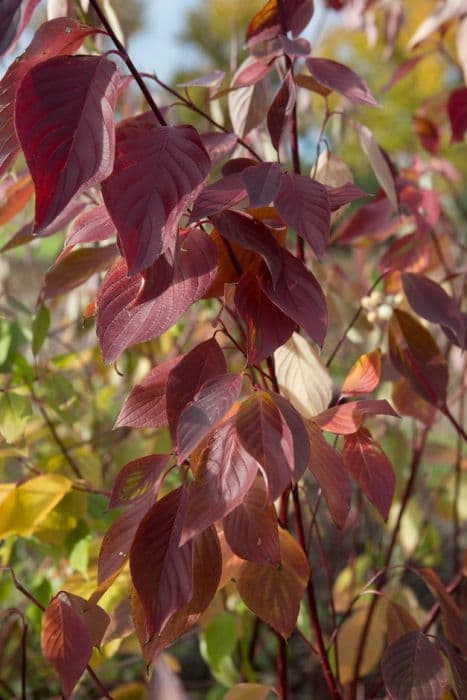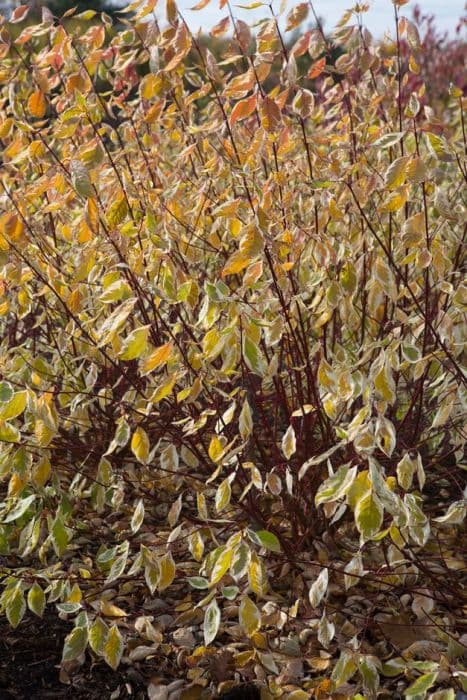Siberian Dogwood Cornus alba 'Aurea'

ABOUT
The Cornus alba 'Aurea', commonly known as the 'Golden Tatarian Dogwood', is a vibrant and ornamental shrub that charms onlookers with its display of colors and textures throughout the seasons. Its leaves are a striking feature, presenting a vivid golden-yellow hue that creates a luminescent effect in sunny garden locations. This bright foliage often transitions to shades of pink and red as the chill of autumn sets in, providing a seasonal spectacle that varies with the passing months. Come spring, small clusters of white flowers emerge, offering a soft, contrasting display against the golden leaves. These are not overly showy but add a delicate touch to the overall appeal of the plant. By summer, the flowers give way to blueish-white berries which are quite appealing to birds and other wildlife, thus adding an ecological benefit to its ornamental value. One of the most noteworthy characteristics of the 'Golden Tatarian Dogwood' is its bark. During the winter, when the leaves have fallen, the shrub reveals bright red stems that stand out dramatically against the starkness of the snowy or gray winter landscape, providing visual interest in a season when color is scarce. The foliage texture of this shrub is smooth with leaves that typically have pronounced veining, adding depth and complexity to the visual experience. The growth habit of 'Golden Tatarian Dogwood' is generally rounded, with a well-branched structure that creates a full and lush appearance. Overall, the 'Golden Tatarian Dogwood' is celebrated for its year-round beauty, making it a favored choice for gardeners looking to enhance their landscapes with enduring color and varied interest. Its ability to offer visual charm in every season makes it a versatile and highly decorative plant for a variety of outdoor settings.
About this plant
 Names
NamesFamily
Cornaceae.
Synonyms
Golden Tartarian Dogwood, Yellow Twig Dogwood, Golden-Twig Dogwood, Siberian Dogwood 'Aurea'.
Common names
Cornus alba 'Aurea'.
 Toxicity
ToxicityTo humans
The plant commonly known as Red Twig Dogwood (Cornus alba 'Aurea') is not considered highly toxic to humans. However, ingesting parts of the plant, particularly the fruit, can result in discomfort or symptoms such as nausea, vomiting, and diarrhea if consumed in large quantities. As with many garden plants, it is advisable to avoid ingesting parts of this plant and to supervise children and inform them not to eat any part of ornamental plants.
To pets
The Red Twig Dogwood (Cornus alba 'Aurea') is also not known to be highly toxic to pets. Nevertheless, consumption of parts of the plant, especially the berries, can lead to gastrointestinal upset in animals such as dogs and cats. Symptoms might include vomiting, diarrhea, and, rarely, weakness or lethargy if ingested in significant amounts. It is prudent to prevent pets from eating this plant, and if they do consume some and show symptoms, it's a good idea to consult with a veterinarian.
 Characteristics
CharacteristicsLife cycle
Perennials
Foliage type
Deciduous
Color of leaves
Variegated
Flower color
White
Height
6 feet (1.83 meters)
Spread
5 feet (1.52 meters)
Plant type
Shrub
Hardiness zones
3
Native area
Asia
Benefits
 General Benefits
General Benefits- Ornamental Appeal: Cornus alba 'Aurea' offers year-round beauty with its variegated golden-yellow leaves, bright red winter stems, and white spring flowers.
- Wildlife Attraction: The plant provides food in the form of berries for birds and can be a habitat for various wildlife species.
- Erosion Control: Its extensive root system helps stabilize the soil, preventing erosion, particularly helpful in sloped gardens or near water bodies.
- Seasonal Interest: This cultivar has seasonal interest with different colors and textures throughout the year, adding to the aesthetics of garden landscapes.
- Tolerance to Varied Conditions: It is a hardy plant that can tolerate a range of soil conditions and is resistant to many diseases, making it a robust choice for different climates.
- Easy to Propagate: Cornus alba 'Aurea' can be easily propagated through cuttings, making it a cost-effective option for garden expansions or sharing with other gardeners.
- Low Maintenance: The plant requires minimal care once established, needing only occasional pruning to maintain its shape and encourage vibrant stem color.
- Privacy Screen: When planted in groups, it can provide a dense screen that offers privacy to a garden space throughout the year.
- Versatility: Suitable for a variety of landscape uses including borders, foundation plantings, and as a focal point in garden designs.
- Pollinator-Friendly: While the primary benefit is not air purification or medical, it does attract pollinators during its flowering season, supporting local ecosystems.
 Medical Properties
Medical Properties- This plant is not used for medical purposes.
 Air-purifying Qualities
Air-purifying QualitiesThis plant is not specifically known for air purifying qualities.
 Other Uses
Other Uses- The bright red stems of the Red Twig Dogwood can be used in basket weaving to add color and texture to handcrafted baskets.
- During winter, the Red Twig Dogwood's branches can provide a striking visual contrast in snow-covered gardens.
- The plant can be used as a natural way to reinforce riverbanks and manage erosion due to its extensive root system.
- Its dense growth habit makes it an ideal shelter for birds and small wildlife during harsh weather conditions.
- The branches of the Red Twig Dogwood are often used in floral arrangements, especially winter displays for their vivid color.
- It can serve as a privacy screen or a living fence when planted in a tight row along property boundaries.
- The shrub can be used as a backdrop plant in garden compositions to highlight lighter colored plants in front.
- Employed as a natural dye, the bark and leaves may yield colors for fabric or other materials.
- In landscape design, it can be used for creating a focal point due to its distinctive color, especially in winter.
- For photographers and artists, the Red Twig Dogwood can be a captivating subject across seasons, especially with its transition of colors.
Interesting Facts
 Feng Shui
Feng ShuiThe Red Twig Dogwood is not used in Feng Shui practice.
 Zodiac Sign Compitability
Zodiac Sign CompitabilityThe Red Twig Dogwood is not used in astrology practice.
 Plant Symbolism
Plant Symbolism- Hope: The vibrant growth of Cornus alba 'Aurea', also known as the Golden Twig Dogwood, often symbolizes hope, as it brings brightness and life to gardens even during the dormant winter months when its yellow-gold stems stand out against the snow.
- Resilience: With its hardy nature and ability to thrive in various conditions, the Golden Twig Dogwood represents resilience and the ability to withstand challenges.
- Transformation: This plant is often associated with transformation due to its dramatic seasonal changes—from its bright foliage in the spring to its stark and striking twigs in the winter, reminding us of the constant change and renewal in life.
- Protection: Historically, dogwoods were thought to ward off evil and offer protection due to their strength, and the Golden Twig Dogwood carries the same symbolism.
- Purity: The white flowers that bloom before the leaves emerge in spring bestow the Golden Twig Dogwood with a symbol of purity and innocence.
 Water
WaterThe Golden Twig Dogwood (Cornus alba 'Aurea') should be watered deeply, ensuring moisture reaches the root zone without waterlogging the soil. Typically, watering once a week with approximately 1 to 1.5 gallons of water is sufficient for young plants, while established shrubs may need less frequent watering depending on weather conditions. During hot, dry periods, increase the frequency to prevent stress. Reduce watering in the fall and water sparingly in winter when the plant is dormant. It's important to use well-draining soil to avoid root rot.
 Light
LightThe Golden Twig Dogwood thrives best in full sun to partial shade. It should be positioned in a spot where it can receive at least 4 hours of direct sunlight each day, with some shade during the hottest part of the afternoon to prevent leaf scorch. Adequate light will ensure the most vibrant leaf coloration and healthy blooms.
 Temperature
TemperatureThe Golden Twig Dogwood is hardy and can tolerate a wide range of temperatures, thriving in conditions that are typically between 35°F and 75°F. It can survive minimum temperatures down to -30°F and maximum temperatures up to 85°F. The ideal temperature range for optimal growth is between 50°F and 70°F.
 Pruning
PruningPrune the Golden Twig Dogwood to encourage bright stem color, remove any dead or diseased wood, and maintain its shape. The best time for pruning is late winter or early spring before the new leaves appear. Cut back one-third of the oldest stems to the base annually to promote new growth, which displays the most vivid colors. On young plants, minimal pruning is needed, just enough to shape the plant.
 Cleaning
CleaningAs needed
 Soil
SoilThe Tatarian Dogwood 'Aurea' prefers well-drained, fertile soil with a pH between 5.5 to 7.5. The best soil mix for this plant would be a combination of garden soil, peat moss, and perlite to improve drainage and fertility. Regular application of organic mulch can also benefit the plant's root system.
 Repotting
RepottingTatarian Dogwood 'Aurea' planted in containers may need repotting every 2-3 years, especially if signs of root crowding are evident. Repotting ensures the plant has enough space to grow and access to fresh nutrients.
 Humidity & Misting
Humidity & MistingTatarian Dogwood 'Aurea' is adaptable to a range of humidity levels and typically thrives in outdoor conditions where the humidity matches the regional climate. No specific humidity requirements are necessary outside of normal garden conditions.
 Suitable locations
Suitable locationsIndoor
Ensure ample light, moist well-drained soil, cool winter spot.
Outdoor
Plant in sun or partial shade, mulch, water regularly.
Hardiness zone
3-7 USDA
 Life cycle
Life cycleCornus alba 'Aurea', commonly known as the golden-twig dogwood, starts its life cycle when seeds germinate in spring after a period of cold stratification that breaks dormancy. The seedlings establish themselves and grow rapidly with bright yellow-green leaves, maturing into multistemmed shrubs with upright branches. Throughout spring and summer, the plant undergoes vegetative growth, producing oval-shaped leaves and small, creamy-white flowers which may attract pollinators. Following pollination, the flowers develop into small white berries that are often eaten by birds, aiding in seed dispersal. In autumn, the leaves turn a variety of reds and purples before falling, and the stems turn a bright red or yellow which provides striking winter interest. As a perennial, the golden-twig dogwood enters a period of dormancy in the winter, conserving energy before starting the next growth cycle in spring.
 Propogation
PropogationPropogation time
Late Winter to Early Spring
Propogation: The Red Twig Dogwood 'Aurea', known scientifically as Cornus alba 'Aurea', is most commonly propagated by softwood cuttings in late spring or early summer when the plant's new growth is mature enough to be firm but still retains some flexibility. To effectively propagate from cuttings, a 4 to 6 inch section of a healthy stem is taken, making sure to include at least two or three leaf nodes. The lower leaves are then stripped, and the cut end is dipped in rooting hormone to facilitate root growth. The prepared cutting is placed in a well-draining soil mix, ensuring that at least two nodes are buried beneath the surface. To maintain the necessary humidity levels, the cutting can be covered with a clear plastic bag or placed in a propagator. It is crucial to keep the cutting in a bright location with indirect sunlight and to ensure the soil remains consistently moist but not waterlogged. Rooting typically occurs within a few weeks, after which the new Red Twig Dogwood plant can be gradually acclimatized to ambient conditions before being transplanted to a more permanent location.
![Dogwood [Baton Rouge]](/_next/image?url=https%3A%2F%2Fplants-admin.emdemapps.com%2Fimages%2Fplants%2F%2Fimages%2F604b59cf0fefd.png&w=640&q=75)


![Dogwood [Ivory Halo]](/_next/image?url=https%3A%2F%2Fplants-admin.emdemapps.com%2Fimages%2Fplants%2F%2Fimages%2F604b535cbcb9a.png&w=640&q=75)





![Dogwood [Venus]](/_next/image?url=https%3A%2F%2Fplants-admin.emdemapps.com%2Fimages%2Fplants%2F%2Fimages%2F604b58a531da1.png&w=640&q=75)